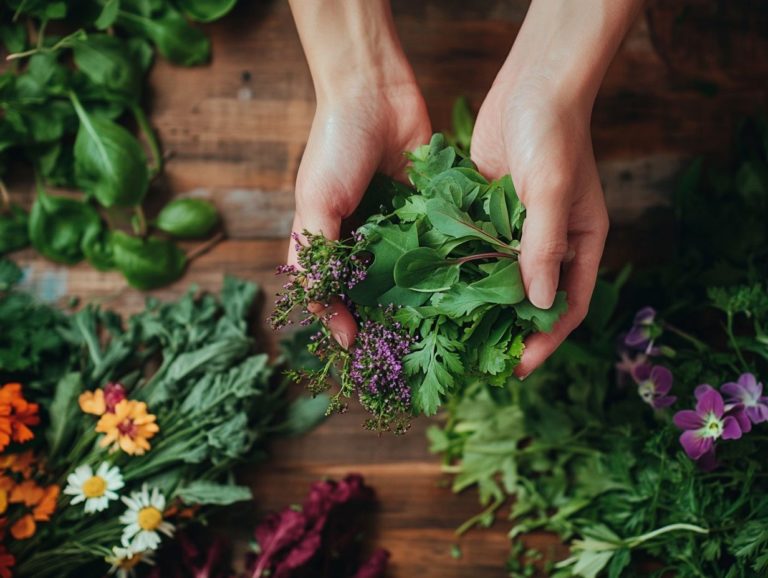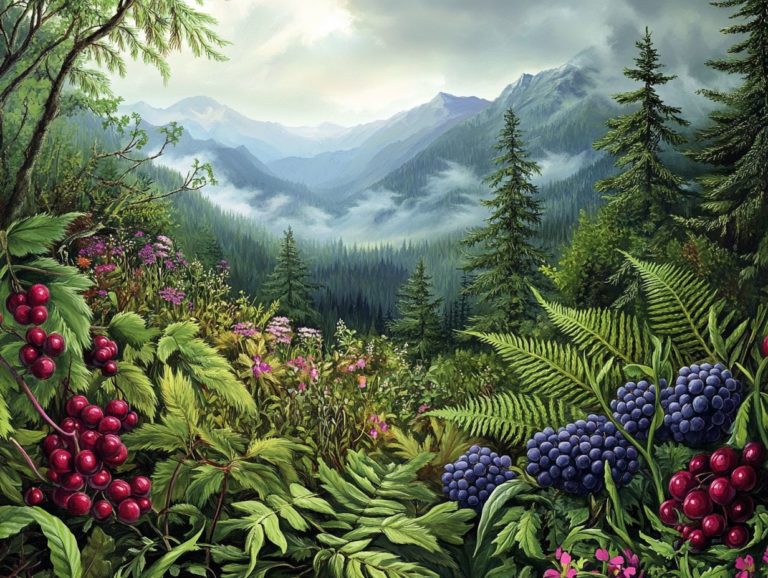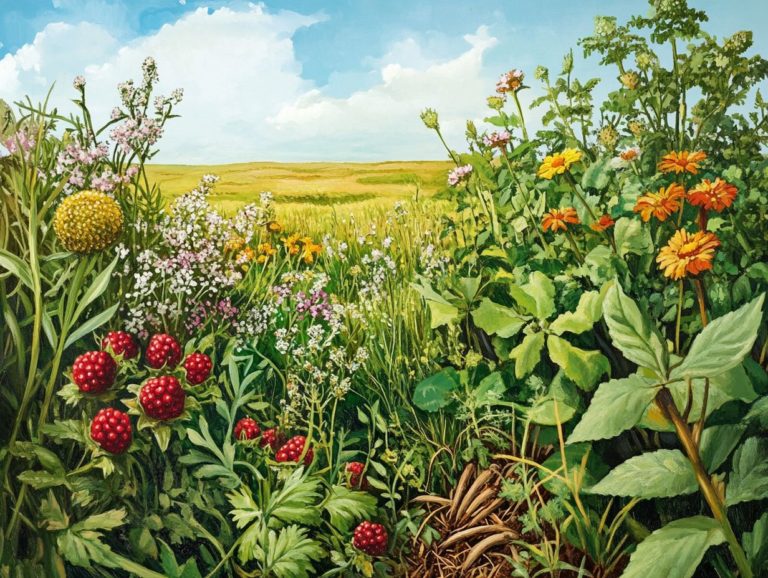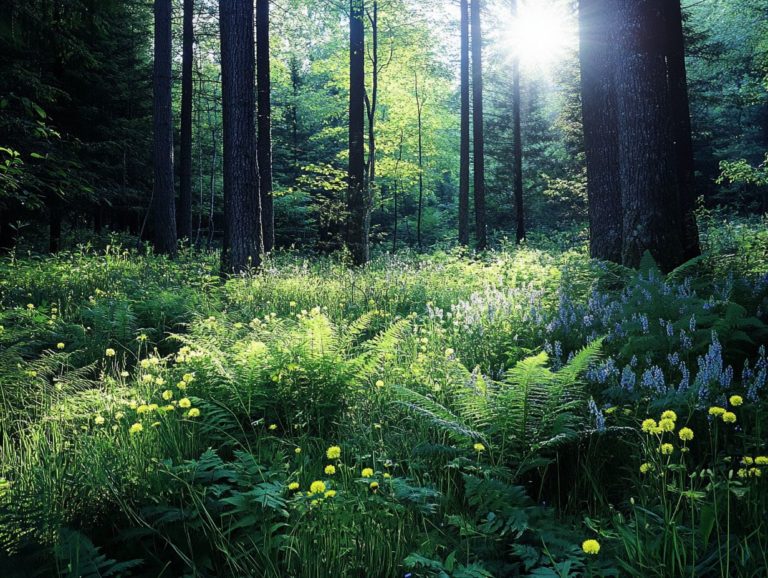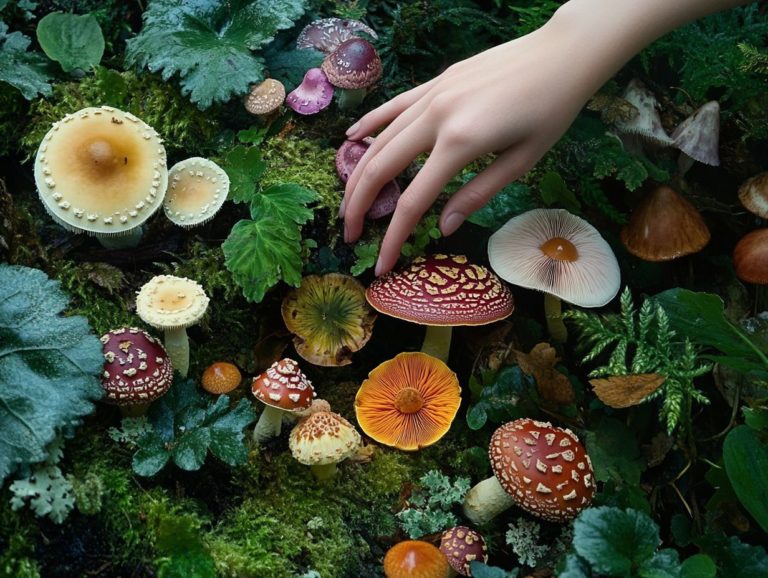Edible Plants and Fungi: A Survival Guide
Understanding which plants and fungi are safe to eat is crucial for anyone with an interest in foraging, survival, or simply elevating their culinary skills.
This guide will empower you to identify key characteristics of edible plants and fungi. It highlights common plants and fungi along with their health benefits and offers practical advice on harvesting techniques and preparation.
This guide also covers potential risks, such as toxic lookalikes and allergies, ensuring that you are fully equipped to explore nature s bounty with safety and confidence.
Contents
- Key Takeaways:
- The Importance of Knowing Edible Plants and Fungi
- Identifying Edible Plants and Fungi
- Common Edible Plants and Fungi
- Harvesting and Preparing Edible Plants and Fungi
- Potential Risks and Considerations
- Survival Tips and Tricks
- Frequently Asked Questions
- What is ‘Edible Plants and Fungi: A Survival Guide’?
- Why is it important to learn about edible plants and fungi?
- How can I identify edible plants and fungi in the wild?
- Are there any dangers associated with consuming wild plants and fungi?
- Can all parts of a plant or fungi be eaten?
- Are there any precautions I should take when foraging for edible plants and fungi?
Key Takeaways:

- Knowing wild edible plants and fungi is crucial for survival in the wild.
- Proper identification skills, gathering wild edibles, and preparation techniques are essential for safely consuming edible plants and fungi.
- In survival situations, edible plants and fungi can provide a valuable source of nutrition and sustenance.
The Importance of Knowing Edible Plants and Fungi
Understanding the significance of edible plants and fungi is essential for anyone seeking to delve into foraging, enhance survival skills, or elevate dietary choices. For those interested, exploring edible fungi can be a great starting point.
By acquiring knowledge of wild edible plants, you can sharpen your skills to identify plants, which proves invaluable in survival scenarios especially in North America.
This expertise empowers you to safely enjoy nature s bounty while helping you avoid poisonous plants that may present health hazards. It helps to know when these plants are available.
Identifying Edible Plants and Fungi
Identifying edible plants and fungi is an invaluable skill for you as a forager. Learning how to spot edible plants in the wild equips you with the knowledge to distinguish between nutritious plants and those that could be harmful.
This journey involves honing your plant identification skills and recognizing common names, key characteristics, and habitat preferences of wild edibles.
By familiarizing yourself with local flora, engaging in backyard foraging, and utilizing field guides, you can significantly enhance your identification process, making it much easier to safely gather wild foods for culinary exploration and nutritional benefits.
Key Characteristics and Features
Understanding the key characteristics and features of edible plants is essential for you as a forager aiming to sharpen your identification skills and ensure safe consumption.
Familiarizing yourself with common names, growth habits, and distinctive traits like leaf shape and flower color is crucial.
Beyond these visible cues, it’s important to consider the specific habitats where these plants flourish, such as wetlands, forests, or meadows, since this can significantly impact their availability.
Pay attention to details like texture, aroma, and seasonal variations. These clues can guide you in making informed decisions about what s safe to eat.
These insights not only streamline your harvesting process but also bolster your confidence when encountering similar plant species. By mastering these characteristics, you can navigate local ecosystems more effectively, transforming foraging into both a practical skill and an enjoyable outdoor adventure.
Common Edible Plants and Fungi
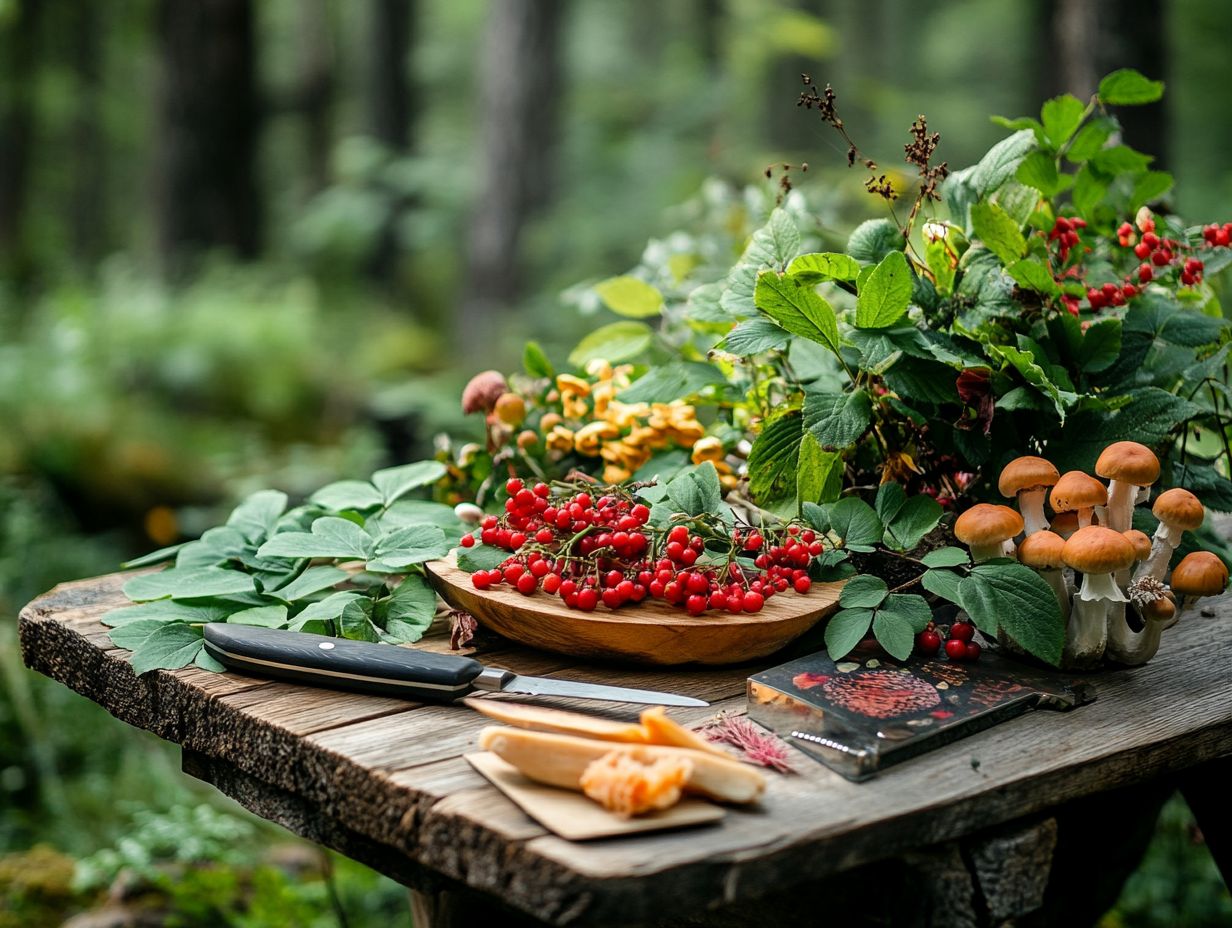
Being well-acquainted with common edible plants and fungi is crucial for anyone embarking on the journey of foraging.
Picture yourself discovering a world of wild edibles! Explore vibrant wild greens, succulent berries, hearty root vegetables, edible roots, and a spectrum of wild mushrooms, all offering unique flavors and health benefits.
By grasping their health benefits, seasonal availability, and understanding cooking techniques, you can significantly elevate your foraging adventures while embracing a diverse and enriching diet.
Types and Nutritional Value
The variety of edible plants and fungi available for foraging offers remarkable nutritional benefits. Acorns are among them, making these foraged foods invaluable additions to your diet.
Take dandelion greens. They are packed with vitamins A, C, and K and have a fresh, slightly bitter flavor that elevates any salad or saut .
Wild leeks have an aromatic taste. They can effortlessly enhance soups or mashed potatoes, adding nutrients and exquisite flavor.
Then there s stinging nettle, which transforms beautifully into pesto or can be steeped into a nourishing tea due to its high iron and calcium content.
By exploring the diverse possibilities of these wild edibles, including wild plant identification and cooking wild food, you elevate your nutritional intake and embrace seasonal ingredients. This fosters a deeper connection to nature and promotes sustainable eating practices.
Harvesting and Preparing Edible Plants and Fungi
Learning how to harvest and prepare edible plants and fungi is essential for anyone venturing into foraging. A valuable resource for this is identifying edible plants in spring, which allows you to savor the rewards of your efforts safely and deliciously.
By mastering proper harvesting techniques, you can collect wild edibles in a responsible and sustainable manner. This ensures minimal impact on the plant populations.
Honing your cooking methods is vital. It helps you transform wild foods into delicious and safe dishes. Adhering to essential safety precautions will protect you from any potential adverse effects.
Proper Techniques and Safety Measures
Implementing proper techniques and safety measures during your foraging adventures is crucial for ensuring both success and safety. You need to be well-versed in the safety guidelines to identify edible plants while avoiding poisonous counterparts.
Familiarizing yourself with sustainable gathering techniques supports environmental conservation. It also helps ensure that wild edible resources remain plentiful for years to come.
Equally important is recognizing common poisonous plants, which often have distinct characteristics like specific shapes, colors, and habitats. Utilizing field guides or apps can enhance your identification skills, giving you the confidence to forage wisely.
Regarding responsible gathering, remember to take only what you need. Leave plenty for wildlife and fellow foragers, as this practice sustains the environment and encourages biodiversity.
Additionally, consider local regulations regarding foraging. Ensuring your activities are legal and ethical contributes to a culture of respect for nature and all its offerings.
Potential Risks and Considerations
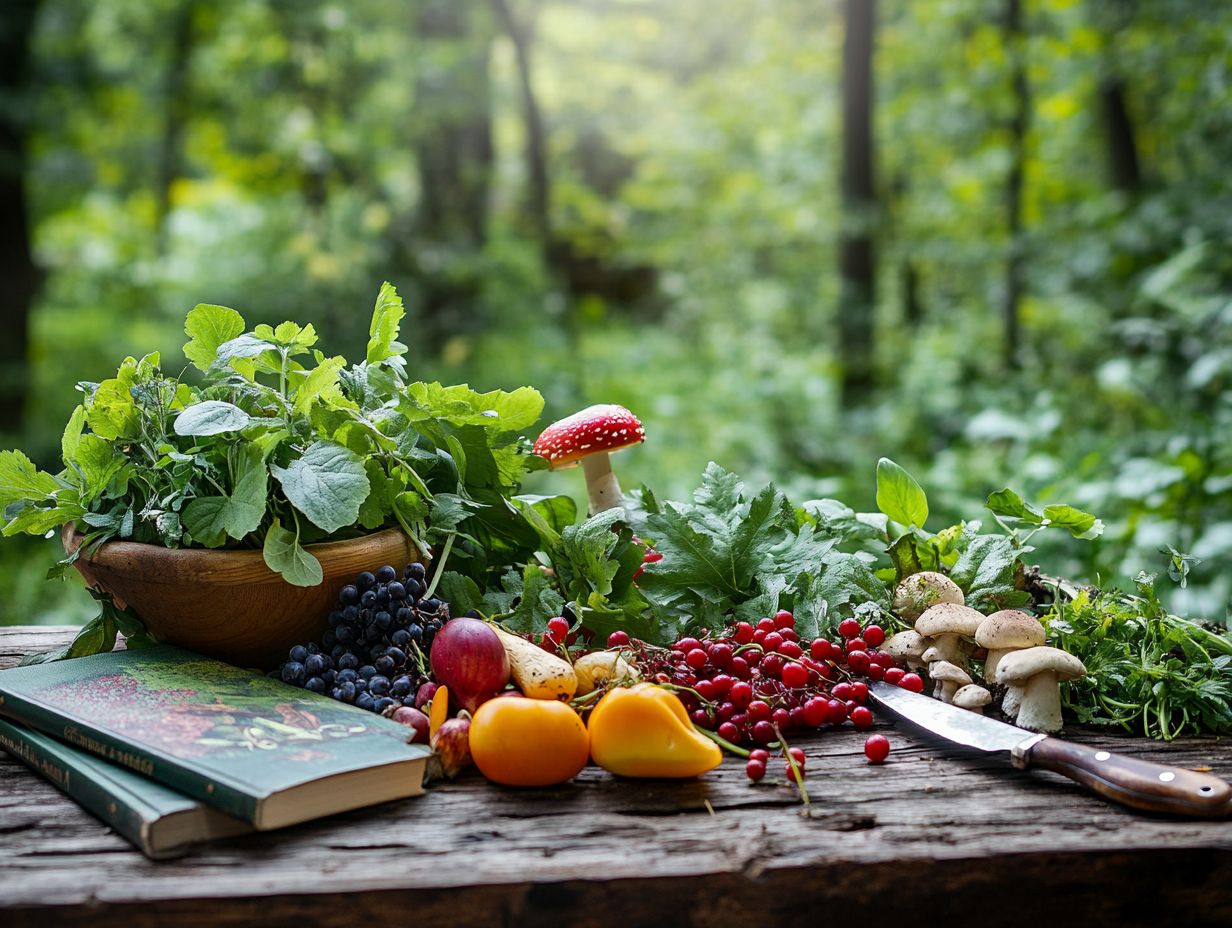
Being aware of potential risks and considerations while foraging is essential for ensuring a safe and rewarding experience in the wild. It s crucial to learn about toxic lookalikes that may closely resemble edible plants. A single misstep can lead to severe health consequences.
Understanding allergic reactions and prioritizing foraging safety will greatly enhance your survival knowledge, especially in emergency techniques during outdoor adventures.
Toxic Lookalikes and Allergic Reactions
Understanding toxic lookalikes is essential for any forager like yourself. This knowledge will help keep yourself safe and avoid consuming poisonous plants that can lead to serious health issues.
Many edible plants have toxic counterparts that may look strikingly similar. This makes it crucial for you to develop strong identification skills.
By honing these skills, you can confidently distinguish between safe and hazardous varieties. This significantly reduces the risk of accidental poisoning. For instance, the familiar wild carrot can easily be mistaken for the toxic hemlock. This underscores the importance of closely examining identifying features like leaf shape and flower structure.
Foraging alongside knowledgeable companions can further enhance your safety. It s also important to be aware of potential allergic reactions, as some edible varieties might trigger adverse responses in sensitive individuals. This understanding enriches your foraging experience and fosters a deeper connection with the natural environment.
Survival Tips and Tricks
Survival tips and tricks focused on foraging can significantly elevate your ability to thrive in outdoor scenarios, especially when resources dwindle.
By harnessing survival knowledge and mastering the art of identifying diverse food sources, you can effectively tap into wild plant resources during emergencies. This expertise is crucial for securing adequate nutrition and sustenance when faced with challenging survival situations.
Using Edible Plants and Fungi in Emergency Situations
Utilizing edible plants and fungi in emergency situations highlights the importance of your foraging skills and survival knowledge, especially when traditional food sources are out of reach. For more information, check out this guide to wild edibles in your backyard.
Mastering these skills allows you to identify and prepare nutritious wild foods, significantly boosting your chances of thriving in challenging environments. A solid understanding of wild cooking and the nutrients that these plants contain can enhance your survival outcomes.
In times of crisis, being able to quickly recognize safe edible options can be a game-changer. For example, getting familiar with common varieties like dandelions or chanterelles, along with foraging for edible fungi in fall, provides immediate sustenance and builds your confidence in foraging.
Implementing practical strategies, such as crafting makeshift cooking methods with hot stones or constructing a fire pit, can elevate the preparation of these wild ingredients. Exploring techniques like drying or smoking can extend the shelf life of your gathered foods, offering valuable resources for longer survival scenarios.
The blend of creativity and adaptability in wild cooking fosters resilience, giving you the power to navigate challenging circumstances with greater ease.
Frequently Asked Questions
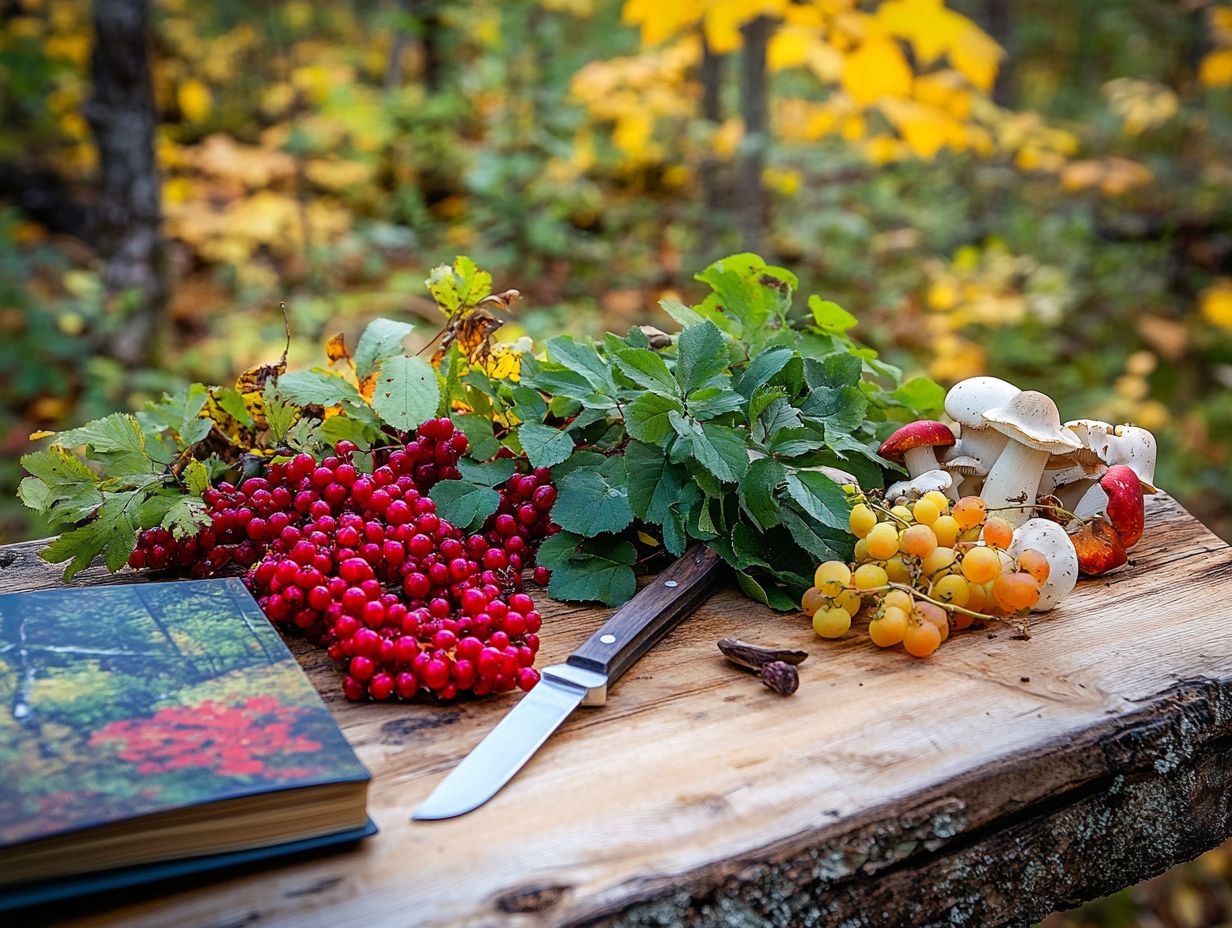
What is ‘Edible Plants and Fungi: A Survival Guide’?
‘Edible Plants and Fungi: A Survival Guide’ is a comprehensive resource about various edible plants and fungi found in nature. It covers identification, preparation, and potential dangers of consuming wild plants and fungi, making it a great companion to wild edible plants: a beginner’s guide.
Why is it important to learn about edible plants and fungi?
Knowing safe plants and fungi can save your life in a survival situation. Additionally, exploring wild edible plants: a culinary adventure can be helpful for foraging and incorporating new ingredients into your diet.
How can I identify edible plants and fungi in the wild?
There are several ways to identify edible plants and fungi, including studying their physical characteristics and using reference guides. Be 100% sure of their identity before consuming.
Are there any dangers associated with consuming wild plants and fungi?
Yes, there are potential dangers, such as allergic reactions and misidentification. It s vital to research and properly prepare any plants or fungi before consuming them.
Can all parts of a plant or fungi be eaten?
No, not all parts are safe to eat. Some may contain toxins or be hard to digest. It s important to research which parts are edible and how to prepare them properly.
Are there any precautions I should take when foraging for edible plants and fungi?
Absolutely! Foraging can be thrilling, but safety is key. Make sure to forage in clean areas free from pollution.
Always wash and cook plants or fungi thoroughly before eating. Enjoy your foraging adventure!

